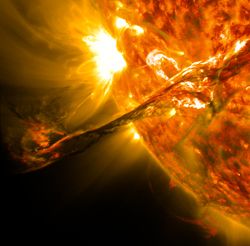After nearly six months of relative quiet, our parent star, the sun, awoke. Recent predictions from leading solar scientists ranged from “cycle 24 will be our weakest yet” to “cycle 24 is quiet now, because it will be double peaked.” It appears that the latter is emerging as the clearer truth.
Over the course of a week, between October 24th and 31st, more than 28 substantial flares fired off from the sun. Several of the more recent flares sent massive clouds of ionized particulate matter, called coronal mass ejections, toward Earth.
Four of the recent flares were X-class solar flares, the strongest on the scale, erupting from the photosphere of the sun, causing minor radio blackouts, and sending coronal mass ejections in many different directions, including toward Earth.
Unfortunately, due to the recent US government shutdown, the suite of tools generally available to the public for space weather prediction were offline. As of November 2nd, there remains a backlog of missing data for several sets of publically available apps and internet resources for space weather prediction and observation.
This period of excited solar activity comes of the heals of recently published science that revealed no discernable connection between the planetary rotation period of Jupiter (11.87 years) and the length of solar cycles (variable between 9 and 12 years). This may sound intuitively obvious, but holdouts from several corners of the scientific world have sought to ascribe significance to the similarities between both cycles. Some claimed that the much less massive Jupiter somehow caused solar dynamic activity.
Published analyses of radioactive isotopes of beryllium and carbon in 10,000 year-old ice core samples recently dismissed the similarities between both periods as being consistent with chance and statistically insignificant. This leaves open the possibility that the solar dynamo is indeed self-excited, in a process whose predictive models are still being tested and perfected, called the meridional flow.
Meridional flow moves solar material just beneath the apparent subsurface of the sun (called the photosphere). Models for the meridional flow have proven difficult to hammer down with predictive certainty, but NASA’s Dr. David Hathaway and a number of other leading solar scientists are moving closer to understanding the dynamic forces that drive the activity of our parent star.
Radar imagery from SDO, taken every 45 seconds over the past two years, was recently analyzed as well. The results of that analysis revealed that the current models, which predict the rate of meridional flow are off by at least half. In short, the conveyor belt-like process of plasma that returns material to the photosphere of the sun moves more quickly than originally theorized. This misunderstanding might have contributed to the lower than normal forecast for solar cycle 24. Time will tell if the sun is truly tapering off its maximum output for this cycle, or if more activity is coming Earth’s way.
The NASA/ESA heliophysics fleet currently observing the sun is comprised of nearly twenty spacecraft in various orbits measuring not only our star, but the interstellar space between it and Earth as well as the intricate space weather system that interacts constantly with our planet.
One of the most exciting moments in solar sciences comes when an Earth-directed coronal mass ejection collides with the Earth’s magnetic field to the degree of causing a geomagnetic storm. The Earth’s magnetic field is fully capable of protecting our planet from the occasional glancing blow from the sun; however, strong clouds of magnetized plasma can often find their way into Earth’s atmosphere, causing minor interference with electrical grids as well as the constellation of GPS satellites.
The Carrington Event of 1859 and the Manitoba Blackout of 1989, revealed that the Earth is indeed vulnerable to space weather events. There have been calls, falling largely upon the deaf ears of US legislators, that want the electrical grid of the United States to be fully retrofitted with radiation hardened components that could handle the surges associated with geomagnetic storms. The problem will not go away and unlike global warming and other self-destructive, human propagated phenomena, there is little we can due to curtail such activity, other than being aware and prepared.
As the number of active regions on the apparent surface of the sun increase, we are likely to experience more geo-effective activity in the coming weeks and months. The phase of the solar cycle remains high and will gently curtail overall activity as solar maximum wanes into the lull of solar minimum.
For solar science enthusiasts, including this writer, this period of solar activity is an ideal time to better understand the dynamic interactions that the sun has with Earth. It is only in the last 10 to 15 years that we’ve understood our parent star to be a dynamic system, not as predictable as we’d assumed it to be in the nearly 400 years of solar science observations.
Deepening the scientific understanding about our parent star is as much about protecting Earth, as it is about examining the interconnected nature of the Earth-Sun space weather system. It behooves all of humanity to keep apprised of this connection as we establish new laws and more accurately understand our extended natural environment.
